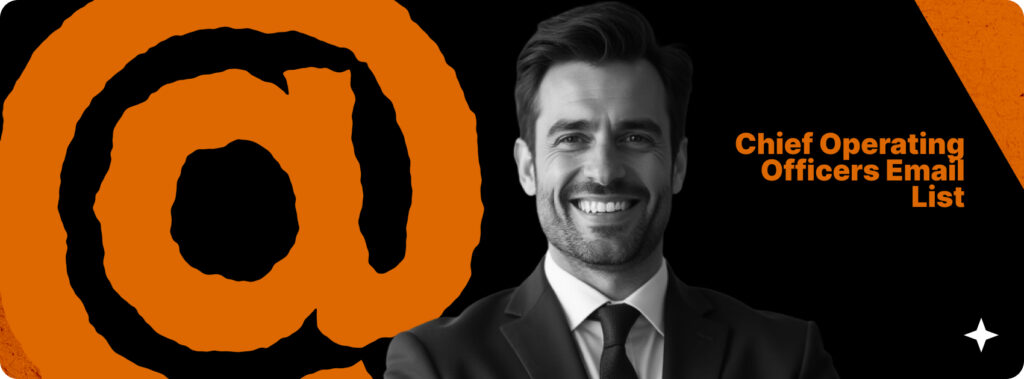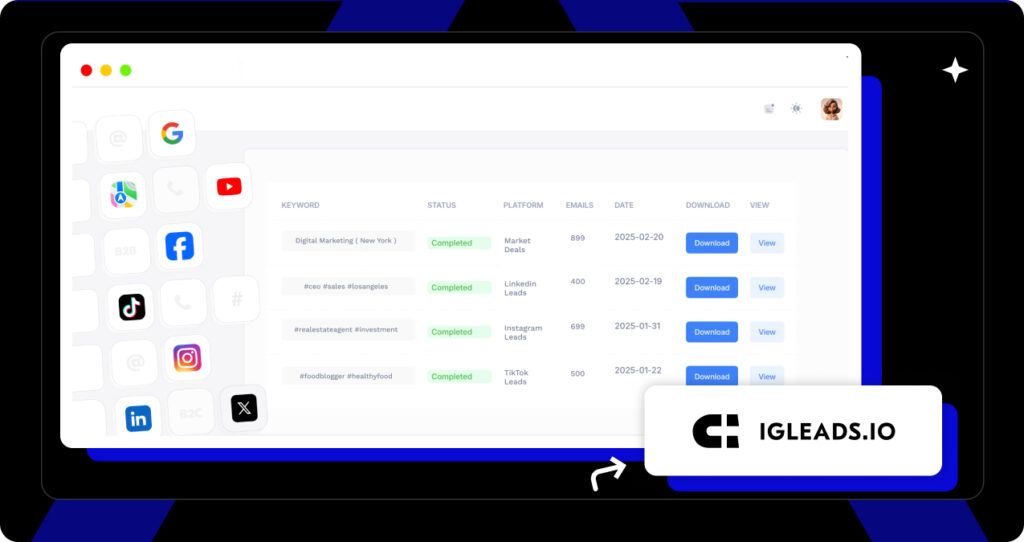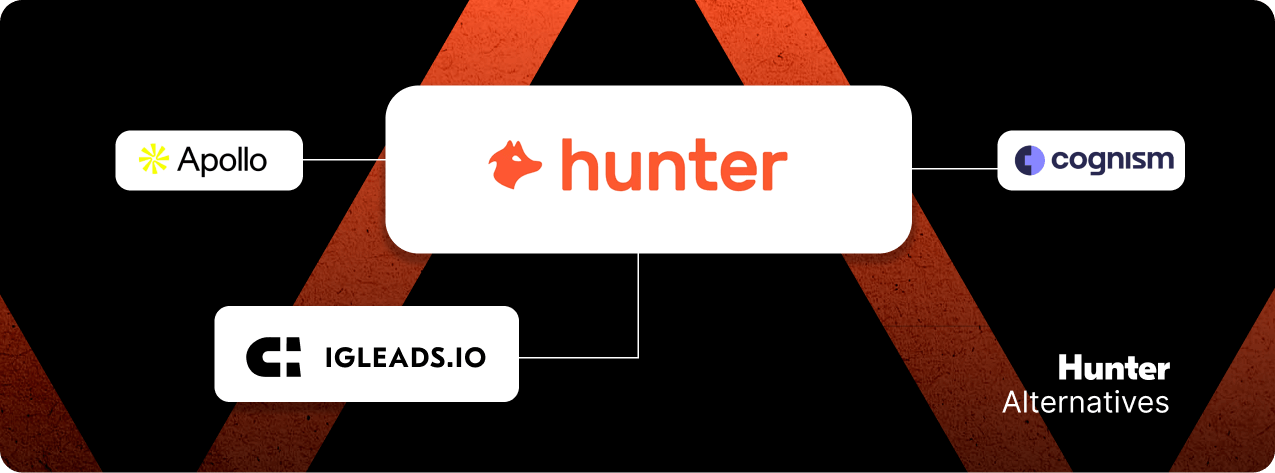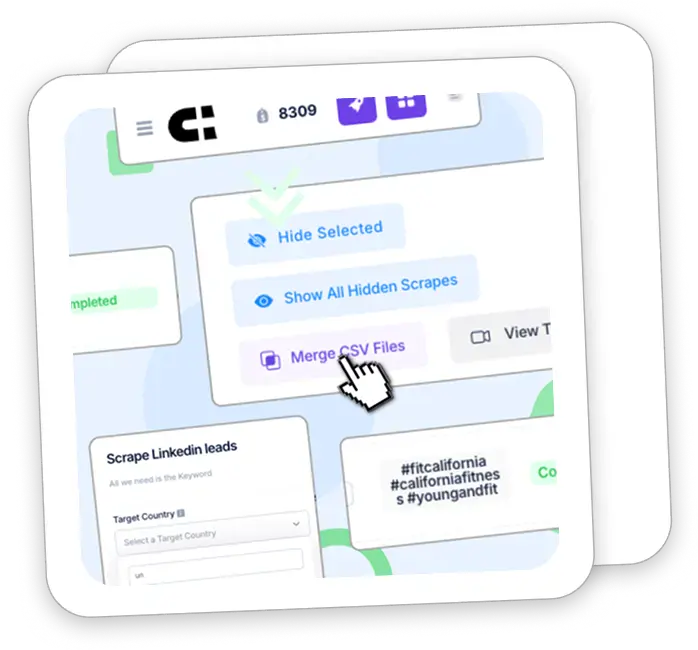Get Fresh COO Email List 2025

COOs turn strategy into execution, making them key buyers for software, tools, and services. Instead of buying outdated COO email list databases, you can build your own with an email scraper, pulling fresh contacts from LinkedIn, company sites, and directories. This guide shows you how in 2025.
Top Ways to Get a Fresh COO Email List
Reaching Chief Operating Officers means getting past gatekeepers and into real inboxes. But most off-the-shelf COO email lists are filled with stale contacts, irrelevant roles, or generic emails that never get opened. If you want to connect with actual decision-makers, the smart move is to build or extract your own list from trusted, real-time sources.
Here are the most effective ways to get a clean, targeted COO email list in 2025.
Use LinkedIn with advanced filters
LinkedIn is still the most reliable source for identifying COOs and operations leaders across industries. With tools like LinkedIn Sales Navigator, you can filter by title, location, industry, company headcount, and even recent job changes.
Tips for LinkedIn search:
- Use titles like “Chief Operating Officer,” “Head of Operations,” or “VP of Operations”
- Filter by company size to match your ICP (ideal customer profile)
- Save searches to build custom lead lists and track changes over time
Use an email scraper like IGLeads to pull COO contact data
Instead of searching manually, an email scraper lets you extract COO data from public platforms at scale. Tools like IGLeads let you select filters by title, company type, industry, and region — and then generate a ready-to-use COO email list in minutes.+
What IGLeads works well for:
- Targeting COOs by niche (e.g. eCommerce, logistics, SaaS)
- Pulling emails from LinkedIn and company websites
- Exporting clean CSVs that plug into CRMs or email tools
No technical skills needed. Just pick your targeting criteria, run the scrape, and download fresh leads.
Explore company websites and leadership pages
Many company websites include detailed leadership bios with names, roles, and sometimes direct contact information. This method is great for high-value accounts or ABM (account-based marketing) campaigns.
Best for:
- Manually verifying senior titles
- Gathering background info to personalize emails
- Building a short list of strategic COO targets
While time-consuming, this method ensures high-quality, verified contacts.
Tap into business databases and directories
Platforms like Apollo, Crunchbase, and ZoomInfo provide rich business data, including job titles and firmographics. While most require a subscription, they offer strong filtering capabilities for pinpointing operations leadership roles.
Look for:
- C-level filtering (specifically “Chief Operating Officer”)
- Company size and industry breakdowns
- Export options with email and LinkedIn links
Always validate contacts before outreach, as even paid tools can include outdated data.
Avoid generic list vendors
Low-cost list sellers often pull from recycled or unverified data sources. These lists might promise thousands of COOs, but you’ll likely end up with low-quality leads, bounce backs, or compliance risks.
If you do consider buying:
- Ask when the list was last updated
- Verify that emails are role-specific, not generic
- Check if the data complies with GDPR and CAN-SPAM
In most cases, building your own list with an email scraper gives you better results and more control.
How to Use Your COO Email List Effectively
A high-quality COO email list is only valuable if you use it the right way. Chief Operating Officers are time-pressed, strategic thinkers who don’t respond to generic outreach. To earn a reply — or even a click — your message needs to be sharp, relevant, and respectful of their time.
Here’s how to turn your list of COOs into real conversations and qualified leads.
Segment your list for better targeting
Not all COOs face the same challenges. Segment your contacts by company size, industry, or geography so your emails can speak directly to their day-to-day concerns.
Examples:
- COOs at fast-scaling startups may care about automation and efficiency
- COOs in manufacturing are focused on logistics and supply chain stability
- COOs at SaaS companies may want better team productivity or analytics
The more relevant your message, the higher your response rate.
Write short, value-driven emails
COOs don’t have time for fluff. Keep your email under 100 words and get to the point quickly. Skip attachments and avoid sounding like a pitch deck.
Use this simple format:
- Line 1: Reference something specific (their company, role, or industry)
- Line 2: Explain why you’re reaching out
- Line 3: Highlight a clear benefit or result
- Line 4: Include a low-friction CTA (calendar link, reply, or intro request)
Make the message about them, not about you.
Use a multi-step email sequence
Don’t rely on one email. Most decision-makers need 2–4 touches before replying. Set up a thoughtful, spaced-out follow-up sequence with different angles and added value.
Example sequence:
- Day 1: Personalized intro with clear benefit
- Day 3: Follow-up with a relevant stat or short case study
- Day 6: Share a helpful resource (guide, report, checklist)
- Day 10: Ask if there’s a better contact or timing
Keep each message conversational and focused on outcomes.
Provide value before you pitch
Earn trust by leading with something useful. COOs respond well to data, benchmarks, and tools that help them make better decisions — even if they’re not ready to buy.
What to offer:
- ROI calculators or cost-savings projections
- Process optimization checklists
- Industry-specific whitepapers or research
- Case studies with quantifiable outcomes
You’re not just selling — you’re helping them do their job better.
Track your outreach performance
Use analytics to improve your messaging. Monitor open rates, reply rates, and click-throughs to find weak points and optimize your approach.
Benchmark goals:
- 40–50% open rate
- 10–20% reply rate for well-targeted lists
- Bounce rate under 2%
Run A/B tests on subject lines, email copy, and CTAs to find what works best.
Best Use Cases and Industries for COO Email Outreach
COOs are laser-focused on making things run better — faster, cheaper, and with fewer moving parts. If your product or service can help streamline operations, reduce costs, or unlock scale, email outreach can be an effective way to open the conversation. The key is aligning your message with the specific outcomes they’re responsible for.
Below are industries where COOs play a pivotal role in purchasing decisions, along with outreach strategies that work.
SaaS and Operational Tech
COOs are often the final decision-makers on software that affects internal workflows, cross-team communication, or customer delivery. They want tools that don’t just sound good — they want tools that work.
When reaching out, highlight:
- Faster implementation or adoption across teams
- Reduced tool sprawl and integration headaches
- Quantifiable improvements (e.g. “Cut ops time by 34% in 90 days”)
A COO doesn’t need a product tour in the first email. They need to know why your platform will make their systems cleaner, not messier.
Logistics, Supply Chain, and Manufacturing
In industries where physical goods, timing, and margin are everything, COOs are the operational architects. Outreach that references specific bottlenecks or opportunities for streamlining will stand out.
Appeal to their priorities:
- Route or delivery optimization
- Inventory visibility or automation
- Better vendor management systems
Even a 5% efficiency gain at scale could mean hundreds of thousands in recovered value — and they know it.
Consulting and Strategic Ops Services
When internal teams hit capacity or leadership is navigating change, COOs often bring in outside experts. This is a great angle if you offer process consulting, ops audits, or implementation services.
Make your pitch resonate by showing:
- You’ve worked with similar org sizes or industries
- You bring clear frameworks — not fluff
- Results, not resumes (“Reduced cross-team errors by 18% in 6 weeks”)
Position your service as a partner in execution, not just advice.
Financial Services and Operational Spend Optimization
Whether it’s procurement, software spend, or general budgeting, COOs are always looking for ways to reduce overhead without sacrificing output. Financial tools, analytics dashboards, or cost-optimization platforms are a great fit here.
What to emphasize:
- Real-time financial visibility
- Overspending alerts or predictive insights
- Easy integration with existing systems
If you can show them where money is being wasted and how to fix it, you’ll get their attention.
Tips for Keeping Your COO Email List Clean and Updated
COOs change companies. They get promoted. Sometimes, they move into advisory roles or launch ventures of their own. That means even the most carefully built COO email list can go stale faster than expected — and a single outdated contact can derail an otherwise strong campaign.
Here’s how to keep your list sharp, relevant, and ready for high-level outreach.
Schedule regular list refreshes
Don’t let your list sit for months untouched. Tools like IGLeads allow you to re-run scrapes based on your original filters, helping you stay up to date without rebuilding from scratch.
Try this cadence:
- Re-scrape every 30–60 days for active campaigns
- Refresh before launching new industry- or region-specific pushes
- Set automated reminders to keep data aligned with real-world changes
Use bounce rate as an early warning signal
If more than 2% of your emails are bouncing, it’s a red flag. COOs may leave companies without updating their profiles — and sending to a dead inbox damages your sender reputation.
Best practices:
- Run your list through an email verification tool before each campaign
- Remove hard bounces immediately
- Track soft bounces and recheck those contacts before your next send
Trim cold or inactive contacts
Even valid emails lose value if they’re unresponsive. If a contact hasn’t opened, clicked, or replied after multiple attempts, it’s time to let them go (or re-engage strategically).
Set a simple rule:
Remove anyone who hasn’t engaged after 3–4 email sequences — unless they’re high-value enough to revisit with a more personalized touch later.
Track job and company changes
A COO moving to a new company doesn’t mean they’re lost — it could mean they now have a bigger budget or different problems to solve. Monitor job changes through LinkedIn or re-scraping filters.
Pro tip:
If someone leaves their role, look up their replacement. Now you have two potential contacts: the person who knows your offer, and the person currently in the seat.
Stay compliant — always
High-level contacts like COOs are more likely to report unsolicited or poorly targeted emails. Avoid legal and reputation risks by following data privacy laws like GDPR, CAN-SPAM, and others in your target regions.
Compliance checklist:
- Always include a visible unsubscribe option
- Never scrape data behind login walls or private profiles
- Document where each contact came from and when
Good data hygiene builds trust — and keeps your outreach efforts sustainable long term.
Real-World Examples of Successful COO Email Outreach
You don’t need a massive list to see results, you need a clean one, the right message, and a value proposition that speaks to how COOs think. These real-world examples show how businesses are using well-targeted COO email lists to land meetings, close deals, and build partnerships at the executive level.
SaaS platform lands high-value demos with mid-market COOs
A project management software company targeted COOs at companies with 100–500 employees in the logistics and distribution space. Instead of buying a list, they used an email scraper to build a segment of 1,200 verified contacts based on title, location, and industry.
Results:
- 46% open rate
- 122 demo bookings in 21 days
- $1.1M in qualified pipeline generated
Why it worked: They tailored each email to operational pain points — focusing on delivery delays, staff coordination, and reporting automation. The list was fresh, the copy was tight, and the sequence avoided bloat.
Ops consultant books enterprise calls with 12-person campaign
An operations consultant targeting enterprise COOs in the healthcare sector scraped just 12 personalized contacts from hospital networks in the Midwest. The initial email included a single case study and a 15-minute meeting link.
Results:
- 6 replies from 12 contacts
- 3 discovery calls
- 1 ongoing contract worth $75K+
Why it worked: The messaging was lean and focused on patient throughput, compliance workflows, and internal friction — issues only a COO would care about. A small list, but deeply relevant.
B2B AI startup runs outbound test, closes early-stage pilots
A machine learning startup targeting COOs in retail and eCommerce built a list of 600 COOs using IGLeads, filtering by companies doing over $5M in annual sales. Their email sequence emphasized automation in inventory forecasting and labor scheduling.
Results:
- 38% open rate
- 47 replies
- 5 pilot deals signed within 60 days
Why it worked: The offer was framed as a test, not a pitch. Their subject lines referenced operational KPIs, and their follow-up emails included visuals from previous deployments.
These aren’t viral campaigns — they’re targeted, disciplined, and operationally aligned. That’s what works with COOs.
What to Do Next With Your COO Email List
Building a COO email list is only the first step. The real results come from how you segment, message, and maintain it. With IGLeads, you control freshness and targeting, but success depends on smart execution.
1. Prioritize by segment
IGLeads lets you scrape by industry, company size, or region. Start with the COOs that best fit your ICP instead of blasting everyone at once.
2. Write one message per segment
Keep it under 100 words. Focus on their operational challenges, efficiency, cost, or scaling, not just your product’s features. IGLeads’ volume of fresh leads gives you room to test messaging quickly.
3. Use a short outreach sequence
Don’t expect replies from the first email. Plan 3–4 steps over 7–10 days. Keep each message useful, adding proof or insights instead of repetition.
4. Track and adjust fast
If open rates drop below 30%, your subject line is weak. If replies are low, your value prop needs work. Test early, learn fast.
5. Keep the list fresh
This is where IGLeads beats static vendor lists. You can re-scrape regularly to capture job changes, promotions, or new hires, ensuring your COO list stays current.
6. Stay compliant
IGLeads only pulls public data, but compliance is on you. Always include opt-outs and respect removals to protect your reputation.
The bottom line: Prebuilt lists might promise higher deliverability, but they go stale fast. With IGLeads, you win on recency, scale, and control, which matters most when targeting COOs who move roles often.
Ready to Reach COOs That Actually Reply?
Generic databases won’t get you far. With IGLeads, you can build a fresh COO email list in minutes using real-time public data. No stale contacts, no endless guesswork — just targeted leads you control from the start.
Find executive and C-suite email lists
- Get Fresh Chief Revenue Officers Email List 2025
- Get Fresh Chief Sales Officer Email List 2025
- Get Fresh Chief Information Officers Email List 2025
- Chief Marketing Officer Email List 2025
- Email Extractor Ultimate Guide 2025
- CFO Email List – Get Targeted CFO Contacts in 2025
- Get Fresh CEO Email List 2025
Explore more lead generation strategies and tools
- B2B Lead Generation Solutions – Guide for 2025
- How to Build a High-Quality B2B Email List for Outbound Marketing
- Buy Email Lists for Marketing in 2025: Complete Guide to Business Leads
- Why Scrape Google Maps? Use Cases for Sales, Marketing & SEO
- B2C Lead Generation: The 2025 Playbook
- 15 Best Lead Generation Companies for 2025
- Best B2B email list providers in 2025
- Top Lead Generation Agencies Compared (2025)
- 18 Best B2B Lead Generation softwares in 2025
- Lead Generation Guide: Strategies & Tools for 2025
Frequently Asked Questions
A COO email list is a curated collection of verified contact details for Chief Operating Officers across companies, industries, and regions.
Use an email scraper like IGLeads to extract real-time COO contact info from LinkedIn, business directories, and company websites — no outdated databases required.
Yes, as long as the data comes from public sources and you comply with privacy laws like GDPR and CAN-SPAM. Always provide a clear opt-out option.
Update your list every 30 to 60 days to reflect job changes, company movements, and email validity. Re-scraping ensures your data stays accurate.
IGLeads, Apollo, and LinkedIn Sales Navigator are ideal for automating contact discovery, filtering by title, and exporting verified COO email lists.





